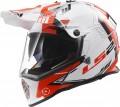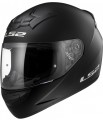Type
The type determines the overall design of the helmet, the features of its application and the level of protection.
—
Integral. Fully enclosed helmets, also known as full face. The shell in such models covers almost the entire head, leaving only a window for the eyes, covered with glass (visor). This provides a good level of protection; in addition, the integrals have a streamlined aerodynamic shape, which is why they are considered the best choice for riding high-speed sportbikes (although they can be used for other purposes). Due to this, this variety is by far the most popular, it is found both in everyday driving and in professional competitions. The main disadvantage of integrals is that the face is constantly covered: for example, to drink water at a bus stop, chat with a fellow traveler or seller, etc. — Helmet has to be removed entirely. In addition, such models are not well suited for driving with intense physical exertion, accompanied by frequent breathing.
—
Open. The most popular type of open models is the so-called 3/4 helmets, in which the shell covers the entire (or almost the entire) head, but leaves the face open. Most of these products also have a transparent folding glass, designed to protect the face from wind, dust and small debris, but do not provide protection from impacts; but there are models without glass. A visor may also be provided. 3/4 helmets are more co
...mfortable in everyday use than integral ones, they do not need to be removed while eating, drinking, talking, etc. On the other hand, their degree of protection is also noticeably lower, especially considering that it is the face that often suffers in motorcycle accidents. Therefore, open helmets are considered suitable only for relatively low speeds; in particular, they are appreciated by the owners of motor scooters. An even lower degree of protection is distinguished by the so-called Helmets (Braincap) — helmets that cover only the upper half of the head. Such products can avoid a fine for not wearing motorcycle equipment and can be used as fashion accessories, but they are not able to effectively prevent injuries in a serious incident.
— Modular. This variety is also known as flip up. It is a kind of compromise between the integrals described above and open helmets. In the working position, the "modular" is practically indistinguishable from full face — it completely covers the head, with the exception of the window at eye level. The difference lies in the fact that the protection for the jaw in such models is made folding or removable — that is, it is possible to open the face without removing the helmet. This provides a combination of good protection, typical for closed models, with the convenience of open helmets. However the level of protection for modular products is still somewhat lower than for integrals — due to the presence of moving parts of the shell. In addition, they are noticeably more expensive and somewhat heavier.
— Cross. Specialized helmets designed primarily for cross-country racing, but also popular with stunt riders. Distinctive features of cross-country models are reinforced jaw protection in the form of a characteristic protruding “chin”, a rather long visor to protect against the sun and dirt, as well as the absence of glass – the helmet is supposed to be used with special motorcycle goggles. Thanks to all this, such models are very convenient with an abundance of dust and dirt, and the level of protection in them is quite high. Another important advantage of cross-country shoes is good ventilation (it is provided based on the athlete's intensive breathing). But the aerodynamics of such helmets is noticeably worse than that of the varieties described above; they are not designed for high-speed driving.
— Enduro. The term "enduro" refers to long, several days, cross-country races. Accordingly, helmets for such races can be described as a "tourist" version of the crosses described above. A distinctive feature of the enduro is that they do not need glasses — the helmet is equipped with a folding glass, as in integral models. Otherwise, cross-country and enduro (also called "super-moto") are so similar that in common parlance they are often not distinguished. And some models of this type even provide the possibility of removing the glass and using it “cross-country”, with glasses.Size
The sizes in which this helmet model is produced.
The appropriate helmet size depends primarily on the circumference of the wearer's head. The circumference is measured at the widest point of the head — usually at a level of 1 – 2 cm above the eyebrows and along the protrusion at the back of the head; more detailed recommendations and descriptions can be found in special sources. Here we note that although manufacturers use the same size designations —
XXS,
XS,
S,
M,
L,
XL, etc. — specific sizes for different brands may vary slightly; for example, XL can fit both 60 – 61 cm and 61 – 62 cm. This seemingly small difference can significantly affect the comfort and safety of use. Therefore, when choosing, you need to be guided by the size tables of a particular manufacturer.
It is also worth considering that helmets with the same size designation may differ not only in actual size, but also in the shape of the internal space. Therefore, even compliance with the size table is not a guarantee that the product will be suitable; the most reliable way is to test the helmet "live" before buying.
Peak
The type of visor provided in the design of the helmet. The visor is a mandatory piece of equipment for cross-country and enduro helmets (see above). It is also often used in open models, and occasionally in modular ones.
The purpose of this part is additional protection from the bright sun, and in some cases also from flying dirt and small debris. The visor can be made removable and non-removable; the first option allows you to remove the visor if necessary (for example, for storage or to improve aerodynamics), the second is considered more durable and reliable, the visor can play the role of an additional element of impact protection.
Features
—
Quick release visor. The ability to quickly remove the helmet visor, in most cases without the use of special tools. Such an opportunity can be useful, for example, for cleaning from pollution, replacing transparent glass with tinted glass, or vice versa.
—
Anti-fog coating. The presence on the helmet visor of a special coating that prevents fogging from the breath of a motorcyclist. This feature will be useful especially in cold weather (glasses practically do not sweat at high air temperatures). It is especially important for closed helmets (integral and enduro, see "Type"), but can also be found in open ones. Note that such a coating is not a 100% guarantee against fogging, but the likelihood of this phenomenon is greatly reduced.
—
Sun visor. A sunscreen in the form of additional tinted glasses that can be lowered and raised as needed, usually by means of a small lever or button on the side of the helmet. Do not confuse this device with tinted glass (see "Visor" above): a sun visor is provided as an addition to the main visor and covers only the eyes. By lowering and raising such glasses, you can “turn on” and “turn off” additional dimming. At the same time, the main visor is most often made transparent, thanks to which the helmet can be comfortably used at night — just lift the built-in glasses and look through the transparent glass. However,
...the sun visor can also be combined with tinted glass; this option will be appreciated by people with sensitive eyes that do not tolerate sunlight well and require enhanced darkening. The disadvantage of this feature is a noticeable increase in the cost of the helmet.
— UV protection. Availability of UV protection in the glass and/or helmet sun visor (see above). Intense ultraviolet light is harmful to the eyes, it leads to their rapid fatigue, deterioration of vision, and sometimes even eye diseases. Moreover, such radiation can be quite intense not only in sunny, but even in cloudy weather; in addition, the amount of ultraviolet increases in mountainous areas as altitude increases. However with short-term exposure, the described effects are hardly noticeable, but even for trips over short distances, UV protection will be useful. And if you are going to travel "far and long" — this feature is highly desirable. Note that if necessary, UV protection can be provided using separate glasses (motorcycle or conventional), but not all helmets allow the use of such glasses.
— Built-in ventilation. The ventilation system usually has the form of holes in the shell — the air flow entering them "blows" the inside of the helmet. This not only provides comfort (especially in hot weather), but also reduces the amount of moisture accumulating inside: the rider's head sweats less than in a fully closed helmet, and the sweat that is released quickly evaporates and is blown into the ventilation. At the same time, many models provide the ability to completely or partially block the ventilation — for example, in cold or rainy weather.
— Breath cutter. Most often found in helmets of a closed design (integrals, modulars, enduro — see "Type"). In such models, it is a kind of visor that covers the nose and mouth of the motorcyclist — so that the exhaled air is discharged into the lower part of the helmet and the visor does not fog up. Also, sometimes cut-offs are called additional masks that are equipped with open helmets, but this is not entirely true — such masks have a slightly different purpose, they are mainly designed to protect the mouth and nose from dust, small litter, insects, etc.SHARP safety rating
The results shown by this helmet model in the SHARP safety rating.
SHARP is a comprehensive testing methodology designed to determine the degree of protection and safety level when using a helmet. Each helmet is tested for direct (linear) impact as well as glide impact friction; in the first case, the acceleration acting on the motorcyclist's brain is measured, in the second, the twisting force acting on the neck is also measured. Tests are conducted for different points of impact, each test involves a minimum of 32 test collisions (more if necessary). The data obtained is compared with information about real injuries, and based on this, the helmet is rated on a five-point scale — from 1 to 5 stars.
The higher the SHARP rating, the safer the helmet and the lower the chance of serious injury while wearing it. However, when choosing this parameter, it is worth considering some nuances. First, the SHARP check is only done on models sold in the UK; and therefore the absence of such certification does not mean poor protection — it may indicate that the helmet simply did not make it to the test. Secondly, the cost of a helmet practically does not affect the number of stars: neither 5 stars for a low-cost model, nor 2-3 stars for a top one are rare. Thirdly, the SHARP programme only checks safety in collisions, it does not affect issues of convenience, aerodynamics, visibility, etc. And even the SHARP experts themselves recommend choosing the most conveni...ent models first, and only then choosing the option with the highest number of stars.
Country of origin
The country of origin is usually considered as the country of origin of the brand — the "homeland" of the company that sells helmets. At the same time, the actual place of release may not coincide with the claimed country of origin, but this is not critical — the quality of the product is determined more by the reputation of the brand (and the thoroughness of quality control) than by the country of actual production.

